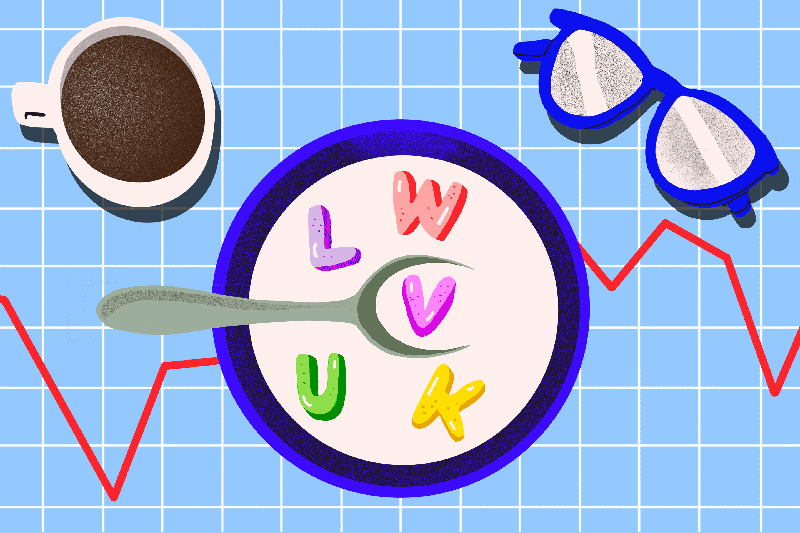V-Shaped, K-Shaped, W-Shaped: These Are the ABCs of Economic Recovery

After a rough spring and a touch-and-go summer, the U.S. economy is finally starting to improve. Even though the country is still in a pandemic-induced recession, experts are starting to predict what recovery might look like. They’re always throwing around letters to describe the trajectory: U-shaped, L-shaped, K-shaped.
To the average reader, it probably sounds like alphabet soup. What are all of these recession “letters,” and what do they mean?
Derek Klock, a certified financial planner and professor of practice in Virginia Tech’s finance department, said recoveries are often charted in letter form because regular, non-economist people can easily interpret them.
“It just gives visual learners a way to grasp what is going on in as few words as possible,” he adds.
The line on the graph is the gross domestic product, or GDP, which is often used as a proxy to describe how the nation is faring economically. The left side of the letter shows how the recession begins, and the right side shows the return to normal. The steeper the line, the quicker the decline/increase.
A V-shaped recovery is where the economy has a pretty fast decline, but it proves temporary and things get back to roughly the same spot without much delay. An L-shaped recovery is a sharp drop in GDP followed by a long stagnant period with little growth. A U-shaped recovery is where the economy bottoms out for a while before rising, and a W-shaped recovery is when the economy recovers fully but then takes a second dip down shortly thereafter.
Daniil Manaenkov, the chief U.S. economist at Research Seminar in Quantitative Economics, said there’s also the K-shaped recovery, a “new invention” of sorts that refers to how different sectors of the economy recover at different speeds.
So what letter is this recession? Depends who you ask.
The White House has insisted we’re seeing a V-shaped recovery. Democratic presidential nominee Joe Biden has argued it’s K-shaped, where wealthy people are recovering fine but lower-class Americans continue to struggle (especially without expanded unemployment benefits and/or a second stimulus check).
According to Manaenkov, economists so far have seen “a checkmark recovery or square root sign, but it’s not a catchy term.” He added that an L- or U-shaped recovery could also be possible depending on what happens with the election, social attitudes toward the pandemic, federal relief and such.
Gabriel Mathy, an assistant professor of economics at American University, predicted it could be a Nike swoosh-shaped recovery, where "we would see an initial fast recovery that then slows down."
Klock said the best shape he can think of is a zigzag: specifically, the inverse of the U.S. confirmed daily COVID-19 cases chart.
“The worse the virus gets, the worse the economy is going to get,” he says. “Until we have a vaccine that is both trusted and economically viable, we’re going to be in this ebb and flow.”
That’s because recovery is tied to people feeling physically safe and financially secure enough to go out and spend money. If there’s a second (or third) wave of lockdowns, it could further hamper the country’s rebound.
It’s also difficult because so much economic data is backwards-looking. Like how the National Bureau of Economic Research doesn’t formally declare the country in a recession until months in, it doesn’t call the end until things are well over. Plus, there’s no precedent for this.
“It’s typically been one of two things that has created economic chaos: something endemic to the economy, or it has been war,” Klock adds. “This is different. This is the first time where we’ve had a completely exogenous event do this to the global economy.”
The bottom line? Politicians, economists and the like are using letters to talk about the economy because it’s an easy way to describe the path of recovery. But nobody can agree on what shape this recession may take: President Donald Trump says V, Biden says K, and some economists don't even want to use letters.
It’s also important to remember that just because the economy is rebounding doesn’t mean every single American will immediately be better off/back to where they were in March. Everything is uncertain — personal impacts included.
“We are just as good as data tells us to be, and the data is very, very noisy at the moment,” Manaenkov says. “We’re watching this unfold in real time.”
More from Money:
How Does the Trump Economy Compare to Obama’s? A Look Back at 4 Key Data Points
What You Can Expect From the Coronavirus Recession, According to Economists
